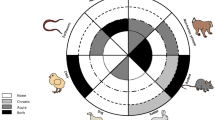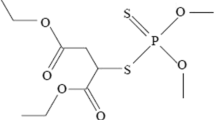Abstract
Various organophosphorus compounds with low acute toxicity are predominantly used as insecticides worldwide. Human acute organophosphorous poisoning often occurs as a result of accidental, criminal or suicidal ingestion. We determined the effect of rat age and lipid solubility of organophosphates on acute organophosphorus poisoning.
After trichlorfon with high water solubility was administered to rats, it and its metabolite, dichlorvos, rapidly disappeared from blood, liver, kidneys and fat-tissues, and the ChE activity in the serum, erythrocytes and brain was rapidly normalized. Dichlofenthion disappeared very slowly from poisoned rats due to its fat-solubility. ChE activity was inhibited for a long time by dichlofenthion released from adipose reservoirs in the whole body, especially in 40-week-old rats, and normal and obese rats at 80 weeks of age. Three-week-old rats, which were at a sexually immature developmental stage, showed mild symptoms of dichlofenthion poisoning. By contrast, 7-week-old rats were poisoned most severely with dichlofenthion and their ChE activity was the most severely inhibited among 3-, 7-, 40-and 80-week-old rats. The recovery of ChE activity in rats poisoned with fenitrothion was the most protracted because of the rapid aging of ChE phosphorylated by fenitrothion, although fenitrothion disappeared more rapidly from rat tissues than dichlofenthion.
These findings in rats demonstrated that the pattern of recovery and the degree of symptoms of acute organophosphorus poisoning differed with age and the organophosphate.
Similar content being viewed by others
References
Levine RS, Doull J. Global estimates of acute pesticide morbidity and mortality. Rev Environ Contam Toxicol 1992;129: 29–50.
Hayes WJ. Pesticides Studies in Man. Baltimore, Maryland: Williams and Wilkins Company, 1982: 301–453.
Naito H. Poisoning of Industrial Products, Gases, Pesticides, Drugs and Natural Toxins-Cases, Pathogenesis and its Treatment. Tokyo: Nankoudou, 1991: 142–54.
Yamanaka S, Yoshida M, Yamamura Y, Nishimura M, Takaesu Y. A study on acute organophosphorus poisoning-Changes in the activity and isoenzyme patterns of serum cholinesterase in human poisoning. Jpn J Hyg 1993;48: 955–65.
Funk KA, Liu CH, Wilson BW, Higgins RJ. Avian embryonic brain reaggregate culture system, 1. Characterization for organophosphorus compound toxicity studies. Toxicol Appl Pharmacol 1994;124: 149–58.
Funk KA, Liu CH, Wilson BW, Higgins RJ. Avian embryonic brain reaggregate culture system, 2. NTE activity discriminates between effects of a single neuropathic or nonneuropathic organophosphorus compound exposure. Toxicol Appl Pharmacol 1994;124: 159–63.
Yamanaka S. Problems and effects of therapeutic drugs against acute organophosphorus poisoning. Jpn J Toxicol 1988;1: 39–46.
Yamanaka S, Nishimura M, Yoshida M, Yamamura Y, Yamamoto Y. Differences of the post-poisoning course in acute organophosphorus toxicity. Jpn J Hyg 1989;44: 116.
Davies JE, Barquet A, Freed VH, Haque R, Morgade C, Sonneborn RE, Vaclavec C. Human pesticide poisoning by a fat-soluble organophosphate insecticide. Arch Environ Health 1975;30: 608–13.
Yoshida M, Shimada E, Yamanaka S, Aoyama H, Yamamura Y, Owada S. A case of acute poisoning with fenitrothion (Sumithion). Human Toxicol 1987;6: 403–6.
Chiou CT, Freed VH, Schmedding DW, Kohnert RL. Partition coefficient and bioaccumulation of selected organic chemicals. Environ Sci Technol 1977;11: 475–8.
Kudamatsu A. Physio-chemical property, action mechanism and metabolism of Dipterex. Noyaku Kenkyu 1969;16: 26–34.
Hales CN, Kennedy GC. Plasma glucose, fatty acid and insulin concentrations hypothalamic-hyperphagic rats. Biochem J 1964;90: 620–4.
Yamanaka S. Determination of organophosphorus compounds in blood by gaschromatography for diagnosis of acute poisoning. J Clin and Experi Medicine 1990;155: 120.
Voss G, Sachsse K. Red cell and plasma cholinesterase activity in microsamples of human and animal blood determined simultaneously by a modified acetylcholine/DTNB procedure. Toxicol Appl Pharmacol 1970;16: 764–72.
Yamanaka S, Ichioka K, Nishimura M. Effects of organophosphorus compounds and the efficacy of PAM on rat serum cholinesterase activity and isoenzyme. Jpn J Hyg 1981;36: 773–82.
Shibata H, Fujioka T. Enzyme, cholinesterase. Clinic Allround 1991;40: 1474–8.
Kondo T, Yoshida M, Kasahara K. Acute florosis in female rats, time course of inhibition and recovery of cholinesterase in serum and salivary glands. J Dental Health 1976;26: 187–92.
Schmidt E, Schmidt FW. Sex difference of plasma cholinesterase in the rat. Enzyme 1978;23: 52–5.
Maeda K, Kamataki T, Nagai T, Kato R. Postnatal development of constitutive forms of cytochrome P-450 in liver microsomes of male and female rats. Biochem Pharmacol 1984;33: 509–12.
Kamataki T. Differences of cytoshrome P-450 by sex, colonies and species. Charles Rivers Letter 1989; Vol. 2, No. 2: 1–7.
Author information
Authors and Affiliations
Rights and permissions
About this article
Cite this article
Yamanaka, S., Ohta, K., Tomita, Y. et al. Effects on acute organophosphorus poisoning in rats in aging and solubility of organophosphates. Environ Health Prev Med 1, 119–127 (1996). https://doi.org/10.1007/BF02931202
Received:
Accepted:
Issue Date:
DOI: https://doi.org/10.1007/BF02931202




